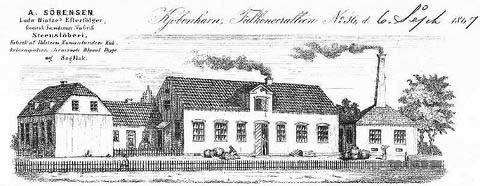
1858 - 1875
Falkoner Alle 36 / Nikolajvej 2 - 6, Frederiksberg
In
1856 Anders Sørensen bought a small factory in Falconer Alle 36
, where he
fabricated concrete rings and other castings and a year later
began to manufacture pencils.
Like so many others before and since Sørensen had also seen the
combination of pencil manufacturing and match stick fabrication,
so at the end of 1857 he began his match stick factory under the
name A. Sørensen & Co.
In 1865 Sørensen
met H. E.
Gosch, there was salesman for the Ludvig Hintze´s match stick
factory which had previously been located in Schleswig , but now
had been moved to Christianshavn, where it had some teething
problems .
After Sørensen had taken over Hintze´s factory in Christianshavn
, he moved all the engines to the new build factory buildings in
Frederiksberg in September 1866. At the same time
Gosch had been employed as a salesman in the company.
In the next years Sørensen constantly built and increased
production .
Since the health authorities had been aware of several cases of
phosphorus poisoning in Sørensen, he got a number of strict
injunction in August 1869.
with a particularly focus on workers ' dining on the premises
and the workers' hygiene while dipping the matches in the
phosphorus solution.
On the 6th of
March 1870 a major fire broke out at the factory , where a
large part of the factory building burned down and the fire
brigade only could concentrate on saving the surrounding
buildings .
Sorensen had then to carry out a major reconstruction , but
within the next months two confirmed a further three fires
appeared, however, which the employees managed to extinguish
before the fire department got there.
At the same time prefect Simony received an anonymous letter
about the miserable working conditions at Sørensen´s factory and
the many cases of phosphornecrosis .
This was the beginning of a major study of conditions in the
industry and resulted subsequently in the well know Match Law.
A written survey of all sites showed that the problem was almost
entirely at Sørensen where they had registered 9 cases , of
which 2 had been ending with the death .
After the Match Law was adopted in 1874 Sorensen had , as many
others, to rebuild his plant matching the new demands, but this
had drained his capital and he also had gotten a bad reputation.
Therefor he tried to " start fresh " by changing the factory to
Frederiksberg Aktie Tændstikfabrik
, where he was to be director the next 5 years and he also
announce that Gosch wouldcontinue as a salesman and bookkeeper
in the company during the same period .
But the sale of shares faltered and as the idea had to be
dropped , Gosch felt free of the agreement and then started for
himself on the island of Amager.
It has previously been written that the reason why Gosch left
Sørensen was a salary issue, but we have not found anything
about this in the context of research for our book , but there
is a coincidence between Sørensen's failed attempts with the
formation of public limited liability company and Gosch starting
his Phoenix-factory .
In an attempt to improve his product and to try to give it a
fresh start , Sørensen´s wife came on the idea to use
Tordenskjold as a factory mark on the labels , as a clear
indication of from
where the match sticks
came .
But Sørensen was beginning to lose his enthusiasm and since this
came to a knowledge for Gosch and his new partner, Oscar
Davidsen out on Amager , they offered , along with some
financiers ( merchant Philip W. Heymann , his brother- merchant
Mentheim Levin Bramson and son-in-law merchant Jacob
Carl Emil Michaelsen ) as guarantors to take over the factory.
The agreement came into being and "A. Sørensen , Louis Hintzes
Eftf "
was now taken over by " H. E. Gosch & Co." for the sum of
approx.
280,000 kroner distributed with DKK 190,000 for buildings and
90,000 kroner for inventory , accounts receivable , etc.
Sørensen, who then had to accept no longer to deal with
manufacturing and selling of matches , continued for some years
in a building on Nikolajvej 11 where he manufactured burial
wreaths and firelighters .
 A. Sørensen Ludv. Hintze´s Efterfølger på
Falkoner Allé
A. Sørensen Ludv. Hintze´s Efterfølger på
Falkoner Allé
